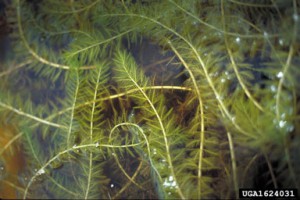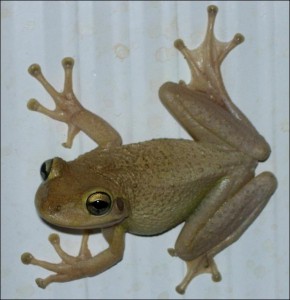March 7th: Eurasian Milfoil (Myriophyllum spicatum), Tiger Prawn (Penaeus monodon), The Cuban Tree Frog (Osteopilus septentrionalis)
Eurasian Water Milfoil: Eurasian water milfoil is a submerged aquatic plant that can be found in northwest Florida in lakes, rivers, and coastal marshes. Water milfoil forms a dense mat of vegetation that can block sunlight and habitat for native plants. These mats can increase water temperatures and interfere with boat traffic, fish habitat, and native aquatic plant species.
Eurasian milfoil was first documented in Florida in 1964. It was reportedly planted by aquarium plant dealers. It is still used today in the aquarium industry and obtained through suppliers and through internet sales. This plant is listed as a category II on the Florida Exotic Species Pest Plant Council List, which means it has the potential to overtake native submerged plant communities.
The spread of Eurasian milfoil can be caused by the breaking of stems and roots, which can be carried by boats, engines and trailers to other lakes and coastal marshes. To help prevent spread of Eurasian water milfoil to Florida’s waters, always clean off your boat, motor and trailer at the ramp to avoid transporting vegetative stems to other areas. In addition, never release or dispose of aquarium plants or animals into local waterways.
For more information, contact the author Chris Verlinde, Marine Science Agent 850-623-3868.
Giant Tiger Prawn: This large shrimp, also known as the Asian Tiger Shrimp and the Black Tiger Shrimp, can reach lengths between 8-12 inches. It resembles are native edible penaid shrimp but differs in that it has distinct black and yellow stripes. It was brought to the U.S. from the Indo-Pacific region as an aquaculture product. There was an accidental release of 2,000 animals from a South Carolina farm in 1988. Reports of this shrimp in the wild have increased over time. They have been found in all Gulf coast states and there has been at least 1 record in each of the Florida panhandle counties. The impact of this shrimp to our area is still unknown but they have a high tolerance for salinity change and consume many types of benthic invertebrates. It is thought that they could become serious competition for our native penaid shrimp and could possible transmit diseases. If you think you have found one of these shrimp, record size location (GPS preferred) and email information to ExoticReports@MyFWC.com. To learn more about this species view the USGS factsheet.
For more information, contact the author Rick O’Connor, Sea Grant/Marine Sciences Agent 850-475-5230.
The Cuban Tree Frog: was introduced into Florida as a stowaway on vehicles and plants in the 1920’s. As of 2013, breeding populations have been recorded as far north as Georgia. Cuban Tree frogs have larger toepads and eyes than any of the native species. Being larger in size, the Cuban Tree frog out-competes other tree frogs for resources, to the point that they are predators of Florida’s tree frogs and inhibitors of native tadpoles. Juvenile Cuban Tree frogs can be distinguished from natives by their red eyes and hind legs with blue bones. Three-foot-long sections of 1.5 inch diameter PVC pipe can be placed in the landscape to monitor for tree frog species. Should Cubans be found, they should be reported and euthanized. For additional details visit: http://edis.ifas.ufl.edu/uw259.
For more information contact the author Sheila Dunning, Commercial Horticulture Agent 850-689-5850.



